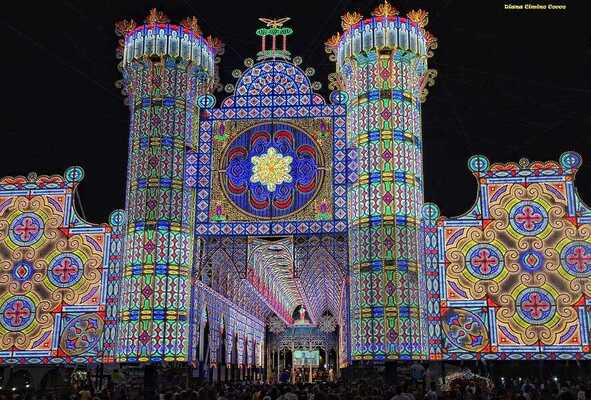Salento pizzica
Salento is known throughout the world, not only for the beauty of its places and the richness of its monuments but also for the charm of its popular traditions. Salento folklore keeps its traditions alive, not only through the memory of the events that once took place in these places, and continues to feel alive and relevant. The Salento pizzica and the tarantate represent a cross-section of life of yesterday and today, they are the pride of the people who live in these places who manage, in a very natural and spontaneous way, to reconcile a globalized world with their own local identity.
The pizzica phenomenon starts from the rediscovery and valorization of Salento popular music, they take on great social and cultural importance, managing to bring together thousands of people in the squares dragged by the sound of the tambourine and hypnotized by the pressing rhythm of the ballads. Pizzica have become a reason for everyone to meet together, young people, the elderly and children, on the streets, in the squares or on the beaches, to rediscover the beauty of small things and simple gestures, to experience moments of union and to communicate with others instinctively, forgetting about everyday problems.
It takes the form of a relief valve, which, in the form of dances and songs, releases all the frustrations accumulated during one’s daily life from one’s body.

The meaning of the Salento pizzica
It is a popular dance and like all “popular arts” it is born and develops in the people and from their suffering. Its roots probably lie in the ancient Dionysian rites of our ancestors and, over the centuries, in the Middle Ages they merged into tarantism. Tarantism is a historical religious phenomenon that has since spread throughout the Salento peninsula until the 18th century and beyond.
It was on the hot and sultry days of June, that some women (mainly women) were stung by the tarantula during the harvest (the wheat harvest) and the resulting reaction was a state of malaise, agitation, and of restlessness, symptoms that were relieved only through the sound of the tambourine or violin. The word then spread and the musicians gathered in the house of the unfortunate woman and, at the incessant rhythm of their various instruments, tried to understand which rhythm reawakened the spirit of the taranta. The attarantata then could dance or simply agitate wildly, even for several days, until once calmed down she could be said to have recovered.
In 1700, the cult of Saint Paul spread in Galatina who, according to belief, healed those who had suffered: every year the appointment was in Galatina in the chapel of Saint Paul on 29 June. Here the attarantate from all over Salento came to be healed by drinking the blessed water from the well adjacent to the chapel, accompanied by musician-therapists. They danced the pizzica, letting themselves be carried away by the sound of the tambourine and violins, mimicking the movements of the tarantula, free from conditioning. Everything was represented to the point of excess, the state of depression and agitation, the hysteria, the state of torpor, the screams. But in the end the Saint performed the miracle.
Role of pizzica as a popular phenomenon
The period of the tarantate was naturally the summer one, but as the phenomenon and the music entered the Salento folklore, the pizzica began to be played, sung and danced all year round on every public or festive occasion. The “tarantate” were then replaced by girls in folk costumes, experts in this seductive dance. Born therefore from the pagan rite of the exorcism of the “tarantate“, the pizzica has progressively acquired autonomy as a rhythmic and musical form, and above all as a popular phenomenon.
Of the original pizzica only three forms remain alive today:
- the pizzica taranta or pizzica-pizzica: it is danced in pairs, not necessarily made up of individuals of the same sex;
- the pizzica de core: danced by a man and a woman together;
- the pizzica scherma: danced only by men.
The last curiosity regarding the Salento pizzica is the handkerchief: it seems, in fact, that it does not belong to the dance tradition, but that it was added later, as an ornament. The dancers’ hands filled with the red of its fabric to add color to the choreography of an already overwhelming dance. Regardless of what its true story may be, the red of that handkerchief is certainly an emblematic symbol of a strong and instinctive feeling, like the love and passion of which it is the banner.
Salento pizzica today: the Notte della Taranta in Melpignano
It is difficult, in recent years, to identify a party or festival, especially in the summer period, that does not include the performance of groups of pizzica players and dancers in its variations. It is therefore even more difficult to list the important events that renew the charm of this rhythm and this dance: some of the most important events take place in Melpignano, Acaya Torrepaduli, Galatina, to which tourists and curious people flock from all over Italy to meet the experts musicians (tambourine players, violinists, guitarists, cupa cupa players…) and dancers from Salento.
On August 26th in Melpignano the spider pinches Salento with the “Notte della Taranta” which is the largest festival in Italy and one of the most significant manifestations of popular culture in Europe, over 100,000 spectators invade the town every year for a unique event of its kind.
The pizzica tells the story of a people, the simple way of life, the customs, the beliefs; we dance united by a ritual that transcends generations, to feel part of a community, to integrate, to communicate with gestures, for play or for love, to touch each other without even touching. The Salento pizzica is magic, it is liberation, it is madness, it is a game of glances and bodies that chase each other, it is cosmic dance and a riot of sounds and colours. If you want to understand a people, listen to their music… what is pizzica if not the beat of Salento?

Illuminations of Salento
In Salento there is a town that celebrates its Saint in great style by combining charm and folklore, tradition and innovation, illuminating with lights and colours: Scorrano, 30 km from Lecce, which has become famous throughout the world for its incredible illuminations

The 10 things to do in Salento
Are you planning your next holidays in Salento? Here are the 10 things to do during your stay in this peninsula jutting out into the Mediterranean.

Apulian singers
Puglia is a region that boasts many scenic, natural, artistic, historical, cultural and gastronomic beauties but not only that... it is also the land where many artists of the Italian musical scene were born who have also become famous worldwide.
